The Meteorological Equipment Market is estimated to be valued at USD 4.0 billion in 2025 and is projected to reach USD 7.5 billion by 2035, registering a compound annual growth rate (CAGR) of 6.5% over the forecast period.
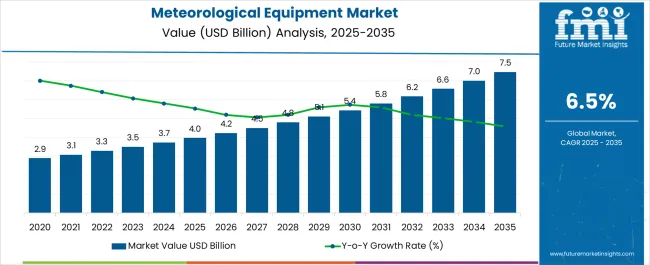
| Metric | Value |
|---|---|
| Meteorological Equipment Market Estimated Value in (2025 E) | USD 4.0 billion |
| Meteorological Equipment Market Forecast Value in (2035 F) | USD 7.5 billion |
| Forecast CAGR (2025 to 2035) | 6.5% |
The Meteorological Equipment market is being driven by increasing investments in climate monitoring, weather forecasting, and disaster preparedness across public and private sectors. The current landscape reflects rising demand from environmental agencies, research organizations, and infrastructure planning authorities, where accurate data is essential for risk mitigation and long-term sustainability. Technological advancements in sensor networks, cloud-based data processing, and AI-assisted forecasting have further accelerated the adoption of advanced meteorological instruments.
Growing concerns related to extreme weather patterns, changing climatic conditions, and the need for real-time data for agriculture, aviation, and energy sectors have expanded the market’s reach. The increasing collaboration between research institutions and governmental bodies has also played a significant role in scaling deployments.
As urbanization continues and industries depend on precise environmental data, the market is expected to witness steady expansion Future opportunities are being opened through the integration of meteorological instruments with IoT platforms, enhancing predictive capabilities and providing actionable insights for disaster management, supply chain optimization, and sustainable development initiatives.
The meteorological equipment market is segmented by instrument, end use, distribution channel, and geographic regions. By instrument, meteorological equipment market is divided into Anemometer, Hygrometer, Thermometer, Barometer, Pyrometer, Ceilometer, Snow Gauge, Seismometer, and Transmissometer. In terms of end use, meteorological equipment market is classified into Research Institute, Weather Forecasting, Chemical Industry, Biotechnical Industry, Weather Station, Environmental Study, Pharmaceutical Industry, and Other (Airport, Technical Institute, Scientific Study). Based on distribution channel, meteorological equipment market is segmented into B2B, B2C, Hypermarkets, Specialty Stores, Online Stores, and Others (Electronics, Scientific Equipment Stores). Regionally, the meteorological equipment industry is classified into North America, Latin America, Western Europe, Eastern Europe, Balkan & Baltic Countries, Russia & Belarus, Central Asia, East Asia, South Asia & Pacific, and the Middle East & Africa.
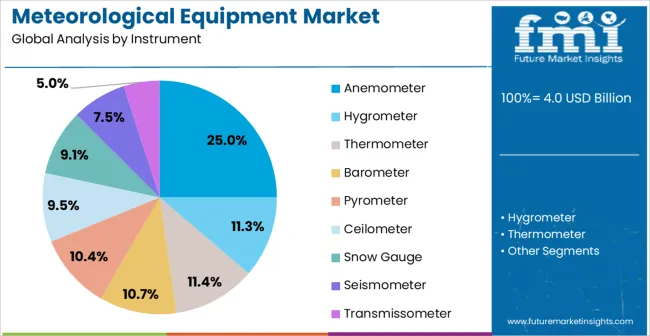
The Anemometer segment is projected to hold 25.00% of the total Meteorological Equipment market revenue share in 2025, making it a leading instrument type. This position has been supported by the critical role it plays in measuring wind speed and direction, which is essential for weather forecasting, aviation, renewable energy projects, and maritime operations. The segment has benefitted from increased deployment in regions where renewable energy sources such as wind farms are being expanded.
Furthermore, its integration with advanced data processing systems has allowed for more accurate forecasting models, contributing to safer operations and better planning in sectors like transportation and disaster management. The rising importance of climate monitoring for agriculture and urban planning has also reinforced demand for this instrument.
The affordability and modular design of anemometers have further aided widespread adoption across research centers and field installations As industries increasingly depend on accurate environmental data for operational efficiency and safety, the Anemometer segment is expected to maintain its significant market presence in the years ahead.
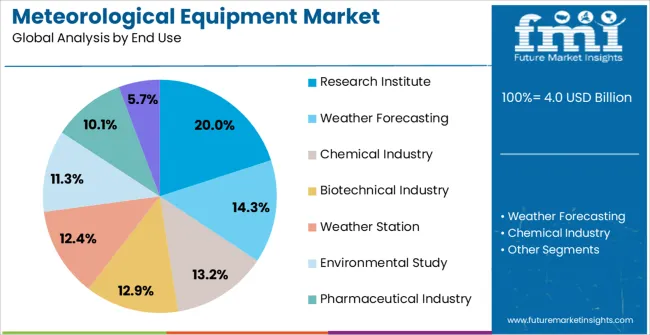
The Research Institute segment is estimated to account for 20.00% of the Meteorological Equipment market revenue share in 2025, establishing itself as a key end-use category. This prominence is being attributed to the increasing reliance of research organizations on precise environmental data for climate studies, weather modeling, and disaster risk assessments. Research institutes are being provided with advanced instrumentation tools, allowing them to gather real-time information, test new forecasting algorithms, and analyze historical data patterns.
The focus on climate change monitoring and global warming mitigation strategies has encouraged deeper collaborations with meteorological equipment providers. Additionally, research-driven initiatives for agricultural optimization, renewable energy exploration, and infrastructure planning have expanded the usage of instruments in controlled and field environments.
Funding support from governments and international bodies has further fueled investments in data-driven research, enabling the establishment of modern laboratories equipped with sophisticated sensors The demand for interoperable instruments that can integrate with global data networks is expected to sustain growth in this segment, supporting long-term research and policy-making efforts across multiple sectors.
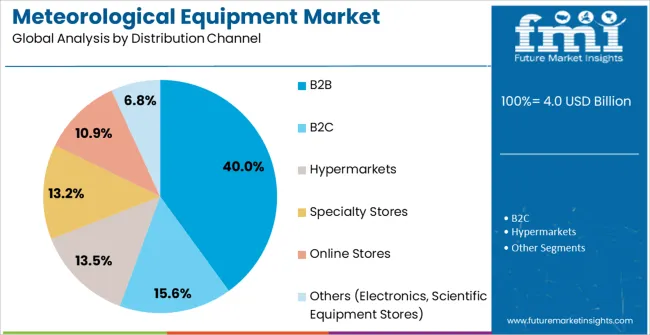
The B2B distribution channel is expected to hold 40.00% of the Meteorological Equipment market revenue share in 2025, making it the dominant channel for equipment deployment. This leadership is being driven by increasing collaborations between manufacturers and industry-specific buyers, such as aviation companies, energy providers, research organizations, and governmental bodies. Business-to-business networks have allowed for tailored solutions where instruments are integrated with existing infrastructure and operational systems.
The ability to customize sensors, software platforms, and data management tools has made B2B partnerships highly effective in meeting specific monitoring requirements. Additionally, long-term service agreements, maintenance contracts, and training programs have strengthened client relationships, encouraging repeat business.
Procurement processes that emphasize technical reliability, compliance standards, and after-sales support have further driven the preference for B2B channels over direct-to-consumer alternatives As industries increasingly prioritize data-driven decision-making and operational safety, B2B networks are expected to continue playing a crucial role in expanding market penetration and enhancing adoption rates across multiple sectors.
Meteorology deals with the study of different weather conditions occurring in the earth’s atmosphere. The equipment used in these studies are known as meteorological equipment. These meteorological equipment are used for the measurement of different weather parameters such as humidity, temperature, pressure, net solar radiation, wind speed, precipitation (snow/rain), and cloud cover.
The primary purpose of making the meteorological equipment is to make the safe environment and prevent hazards and accidents. The first meteorological types of equipment were manufactured in the 15th century to measure the weather-related variables.
Anemometer, rain gauge and hygrometer are the meteorological equipment manufactured first. Now, technical advancement and growing research have created ample demand for meteorological equipment.
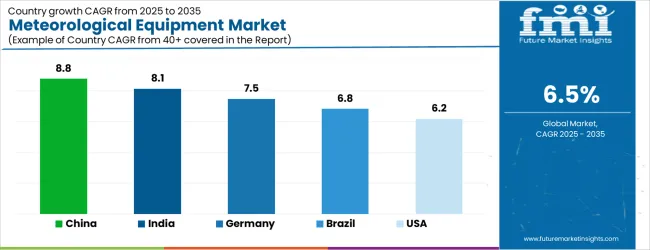
| Country | CAGR |
|---|---|
| China | 8.8% |
| India | 8.1% |
| Germany | 7.5% |
| Brazil | 6.8% |
| USA | 6.2% |
| U.K. | 5.5% |
| Japan | 4.9% |
The Meteorological Equipment Market is expected to register a CAGR of 6.5% during the forecast period, exhibiting varied country level momentum. China leads with the highest CAGR of 8.8%, followed by India at 8.1%. Developed markets such as Germany, France, and the U.K. continue to expand steadily, while the U.S. is likely to grow at consistent rates. Japan posts the lowest CAGR at 4.9%, yet still underscores a broadly positive trajectory for the global Meteorological Equipment Market. In 2024, Germany held a dominant revenue in the Western Europe market and is expected to grow with a CAGR of 7.5%. The U.S. Meteorological Equipment Market is estimated to be valued at USD 1.4 billion in 2025 and is anticipated to reach a valuation of USD 1.4 billion by 2035. Sales are projected to rise at a CAGR of 0.0% over the forecast period between 2025 and 2035. While Japan and South Korea markets are estimated to be valued at USD 190.5 million and USD 125.8 million respectively in 2025.
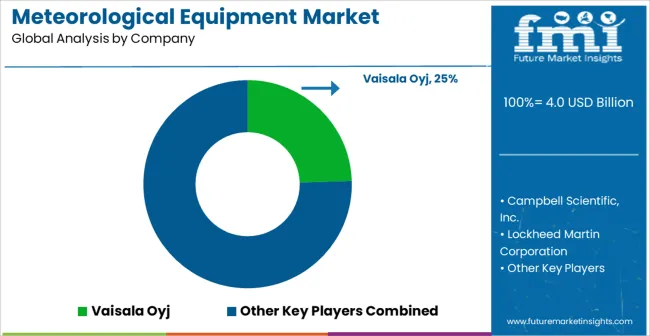
| Item | Value |
|---|---|
| Quantitative Units | USD 4.0 Billion |
| Instrument | Anemometer, Hygrometer, Thermometer, Barometer, Pyrometer, Ceilometer, Snow Gauge, Seismometer, and Transmissometer |
| End Use | Research Institute, Weather Forecasting, Chemical Industry, Biotechnical Industry, Weather Station, Environmental Study, Pharmaceutical Industry, and Other (Airport, Technical Institute, Scientific Study) |
| Distribution Channel | B2B, B2C, Hypermarkets, Specialty Stores, Online Stores, and Others (Electronics, Scientific Equipment Stores) |
| Regions Covered | North America, Europe, Asia-Pacific, Latin America, Middle East & Africa |
| Country Covered | United States, Canada, Germany, France, United Kingdom, China, Japan, India, Brazil, South Africa |
| Key Companies Profiled | Vaisala Oyj, Campbell Scientific, Inc., Lockheed Martin Corporation, The Weather Company (IBM), Airmar Technology Corporation, Gill Instruments Limited, Kipp & Zonen B.V., Baron Weather, Inc., Columbia Weather Systems, Inc., Biral Ltd., Met One Instruments, Inc., All Weather, Inc., Skye Instruments Ltd., Sutron Corporation, Davis Instruments Corp., Lufft Mess- und Regeltechnik GmbH, Belfort Instrument Company, HMEI (Hydro-Meteorological Equipment Industry), Yankee Environmental Systems, Inc., and OTT HydroMet |
The global meteorological equipment market is estimated to be valued at USD 4.0 billion in 2025.
The market size for the meteorological equipment market is projected to reach USD 7.5 billion by 2035.
The meteorological equipment market is expected to grow at a 6.5% CAGR between 2025 and 2035.
The key product types in meteorological equipment market are anemometer, hygrometer, thermometer, barometer, pyrometer, ceilometer, snow gauge, seismometer and transmissometer.
In terms of end use, research institute segment to command 20.0% share in the meteorological equipment market in 2025.






Our Research Products

The "Full Research Suite" delivers actionable market intel, deep dives on markets or technologies, so clients act faster, cut risk, and unlock growth.

The Leaderboard benchmarks and ranks top vendors, classifying them as Established Leaders, Leading Challengers, or Disruptors & Challengers.

Locates where complements amplify value and substitutes erode it, forecasting net impact by horizon

We deliver granular, decision-grade intel: market sizing, 5-year forecasts, pricing, adoption, usage, revenue, and operational KPIs—plus competitor tracking, regulation, and value chains—across 60 countries broadly.

Spot the shifts before they hit your P&L. We track inflection points, adoption curves, pricing moves, and ecosystem plays to show where demand is heading, why it is changing, and what to do next across high-growth markets and disruptive tech

Real-time reads of user behavior. We track shifting priorities, perceptions of today’s and next-gen services, and provider experience, then pace how fast tech moves from trial to adoption, blending buyer, consumer, and channel inputs with social signals (#WhySwitch, #UX).

Partner with our analyst team to build a custom report designed around your business priorities. From analysing market trends to assessing competitors or crafting bespoke datasets, we tailor insights to your needs.
Supplier Intelligence
Discovery & Profiling
Capacity & Footprint
Performance & Risk
Compliance & Governance
Commercial Readiness
Who Supplies Whom
Scorecards & Shortlists
Playbooks & Docs
Category Intelligence
Definition & Scope
Demand & Use Cases
Cost Drivers
Market Structure
Supply Chain Map
Trade & Policy
Operating Norms
Deliverables
Buyer Intelligence
Account Basics
Spend & Scope
Procurement Model
Vendor Requirements
Terms & Policies
Entry Strategy
Pain Points & Triggers
Outputs
Pricing Analysis
Benchmarks
Trends
Should-Cost
Indexation
Landed Cost
Commercial Terms
Deliverables
Brand Analysis
Positioning & Value Prop
Share & Presence
Customer Evidence
Go-to-Market
Digital & Reputation
Compliance & Trust
KPIs & Gaps
Outputs
Full Research Suite comprises of:
Market outlook & trends analysis
Interviews & case studies
Strategic recommendations
Vendor profiles & capabilities analysis
5-year forecasts
8 regions and 60+ country-level data splits
Market segment data splits
12 months of continuous data updates
DELIVERED AS:
PDF EXCEL ONLINE
Equipment Management Software Market Size and Share Forecast Outlook 2025 to 2035
Equipment cases market Size and Share Forecast Outlook 2025 to 2035
Farm Equipment Market Forecast and Outlook 2025 to 2035
Golf Equipment Market Size and Share Forecast Outlook 2025 to 2035
Port Equipment Market Size and Share Forecast Outlook 2025 to 2035
Pouch Equipment Market Growth – Demand, Trends & Outlook 2025 to 2035
Garage Equipment Market Forecast and Outlook 2025 to 2035
Mining Equipment Industry Analysis in Latin America Size and Share Forecast Outlook 2025 to 2035
Subsea Equipment Market Size and Share Forecast Outlook 2025 to 2035
Pavers Equipment Market Size and Share Forecast Outlook 2025 to 2035
Tennis Equipment Market Analysis - Size, Share, and Forecast Outlook 2025 to 2035
Galley Equipment Market Analysis and Forecast by Fit, Application, and Region through 2035
Sorting Equipment Market Size and Share Forecast Outlook 2025 to 2035
General Equipment Rental Services Market Size and Share Forecast Outlook 2025 to 2035
Bagging Equipment Market Size and Share Forecast Outlook 2025 to 2035
RF Test Equipment Market Size and Share Forecast Outlook 2025 to 2035
Medical Equipment Covers Market Size and Share Forecast Outlook 2025 to 2035
Telecom Equipment Market Size and Share Forecast Outlook 2025 to 2035
Welding Equipment And Consumables Market Size and Share Forecast Outlook 2025 to 2035
Hunting Equipment and Accessory Market Analysis - Size, Share, and Forecast Outlook 2025 to 2035

Thank you!
You will receive an email from our Business Development Manager. Please be sure to check your SPAM/JUNK folder too.
Chat With
MaRIA